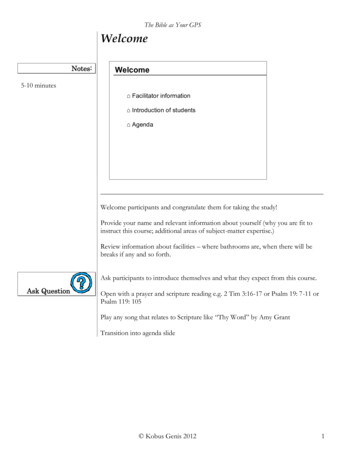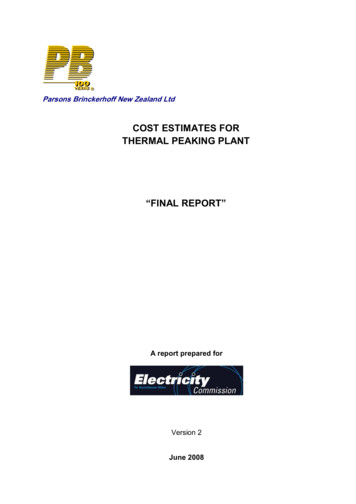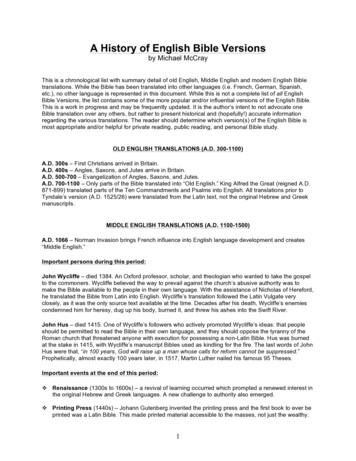
Transcription
APTUS BIBLE
THE APTUS BIBLE PAGE 1PAGE 2 THE APTUS BIBLEINTRODUCTIONINTRODUCTIONINTRODUCTION
MAIN OFFICE & TECHNICAL SUPPORTPhone:Email:Website:THE APTUS BIBLE PAGE 3PAGE 4 THE APTUS BIBLEUnit 1/11 Didswith st, EastBrisbane, QLD, 4169( 61) 07 3040 om.auINTRODUCTIONINTRODUCTIONCONTACTING APTUS
MAJOR COMPONENTSThe Aptus Bible is designed to educate and inform retail store staff and consumersabout Aptus products. it is intended as a robust, behind the counter reference guidefor when customers ask tough questions, or for continuing staff education.INTRODUCTIONThis is no replacement for our live support though. You are always encouraged tocall Product Tech Support or schedule a Skype session with one of our Educators.USING THIS GUIDEThe Aptus Bible is intended as an ongoing reference tool for store staff and educators.You can find information for each product and core concept in each major section.Each of these sections is divided into sub sections based on the level of knowledge.This colour coded layout makes it easy to find the find the appropriate information.BASIC KNOWLEDGEThese are the bullet points. They are deep enough to have a grasp of the ‘what’ ofAptus. WHAT is different about Aptus? WHAT Aptus contains. WHAT it can do forgrowers. Understanding these points gives you enough to talk intelligently withmost customers. It is the bare-minimum for all staff to know.ADVANCED UNDERSTANDINGThere is a portion of the population that asks the tough questions. These points godeeper into the understandings of HOW things work. In these sections the guide getsinto more specifics about HOW the components work together. HOW plants respondto Aptus technologies. HOW Aptus was put together. We recommend at least one staffmember in each store becomes well versed in these deeper concepts.EXTREME EDUCATIONOnly for the hard core knowledge seeker. Most of these concepts will never beaddressed in a typical store setting, but for those who want to truly understand theWHY of Aptus and many plant science concepts in general, these are the sections tounderstand. WHY do plants behave in certain ways? WHY did we make certain decisions when formulating Aptus?THE APTUS BIBLE PAGE 5Aptus Plant Tech is different. And not because a flashy marketing campaign says so.The Aptus story is unique and exciting. The future of Aptus is greater because thebeginnings were great. This section tells the Aptus Story, Philosophy, and Approach.Understanding our story and values sets a basis for the understanding the science,research, and product formulations.APTUS SCIENCEThe research that went into Aptus products came from the top agricultural researchersand universities. The science is highly refined and based fully on the ideal of followingthe biological rules of nature. This section explains the specific science that inspiredAptus.CORE PRODUCT TECHNOLOGIESWith a basic understanding of plant nutrition, product selection is easier. It’simportant to fully understand that what goes into the products that go into yourplants and, in turn, go into you. This section lays out the ingredients and formulationof the Aptus Plant Tech product line. We’ll also discuss why we chose each ingredientin the technologies we use.PRODUCTSThis section details specific product formulation, usage, and education. You’ll findFrequently Asked Questions about specific products as well as general Aptus FAQ.This section is most important for understanding how to sell which products forspecific needs and circumstances.SELLING APTUSOur goal is to build each store into a successful retailer and education center.We’ve found that stores with the most knowledgeable and passionate staff movethe most products and develop a loyal following. There are nuances of Aptus salesthat go beyond typical plant nutrition.PAGE 6 THE APTUS BIBLEINTRODUCTIONINTRODUCTIONSUMMARY & OVERVIEW
“Big Ag” across the globe is experiencing the negative effects of decades of syntheticfertiliser and pesticide usage. Cropland is becoming toxic and barren, soil micro-life isdead, and many minerals have been completely depleted. Salt buildup creates harmfulrunoff into our groundwater, pesticide residue is on much of our produce, and our foodlacks the nutritional value it contained only a few decades ago.Aptus technologies were developed in an effort to fix these problems short term andlong term. By creating highly bioavailable forms of nutrients and natural stimulators,Aptus works immediately on plant growth but also helps to remediate soil and bringlife back to the earth. Truly, if nature is working as designed, there is no need for Aptus or any other human input!After six strong years in the professional agriculture sector, Aptus moved tothe hobby/hydroponics industry. six years later, Aptus has become a dominanthydroponics nutrient Accross europe, north America and Australasia. This rise toprominence is not from million dollar marketing campaigns or aggressive sales tactics.rather, Aptus is built on True plant science so growers experience quality, efficiency,and cost savings alike.our companies in europe, north America and Australasiaare built on the idea that people are most important. The rapid growth is fueledby focusing on educating stores and end users with real science and providingreliable, proven formulations.THE APTUS BIBLE PAGE 7We strive for excellence in everything we do. This applies to nutrients, client serviceand quality of our public image and beliefs. Our three core brand pillars are:Education – Everything we do begins with proper education. We teach maximisingplant genetic potential through natural, science based nutrition technologies. Our chiefdesire is to create a community of growers who understand why they achieve success.Quality – We are vigilant of the quality of our ingredients, distribution channels,and staff. Growers can be confident that their plants receive no synthetic or harmfulmaterials from Aptus products—only natural nutrition.Value – All our products are designed to maximise the end user’s value experience.The high concentrations of our nutrient formulas mean low cost per use and minimalwaste. Growers typically achieve superior quality and increased yields for far less cost.PAGE 8 THE APTUS BIBLEINTRODUCTIONINTRODUCTIONTHE APTUS PHILOSOPHYTHE STORY OF APTUS
MODERN AGRICULTURE, HOW DID WE GET INTO THIS MESS?The Aptus Approach is to provide quality uniform products and education that enhancegrowers’ production and cultivation. The Aptus Approach is based on a preventivemethodology for host (plant), pest and environmental problems. Simply put, to avoidproblems before they become problems.The market certainly doesn’t need another plant nutrient. It seems there is a newnutrient line every month. And for the most part, they are all the same. Theycontinue to create the same problems as the brand before them. That’s becausethey are all based on the flawed mentality that drives modern agriculture.The Aptus Approach is natural; it fully respects the rules of nature and is a guidelineto get back to ancient natural mechanisms: soil care and plant care. Aptus is thecombination of soil bioremediation, plant stimulation, and proper nutrition.Look where that mindset has gotten us:GROWER GOALSAll growers, regardless of plant type, background, location, etc, have four primarygoals for their operation.1) Larger yields2) Increased quality Exhaustion of carbon from the soil Disappearance of micro-organisms from the soil Disappearance of essential micro-elements (silicon, selenium) Soil acidification (unfriendly to most plants) Weak plants with low mineral content and little natural resistance3) Cost savingsThese problems are just the beginning, and unfortunately most of the ‘solutions’offered for these problems, can create even greater problems. Some of them include:4) Less work Toxic chemical runoff into water sources (pesticides, herbicides, fungicides)Growers can spend their entire career pursuing the fulfillment of these goals. And because of slick marketing campaigns and snake oil salesmen, many are duped time andagain into trying magic potions that promise all of the above. The truth is far different, and much simpler. Poisoned soil and air Vast wastelands of industrial manufacturing byproducts Massive carbon footprints for food productionAptus believes that these goals can be reached by aligning our operations withprinciples that obey the rules of nature. Plants want to be healthy, to be robust andnutritious, to produce flavours, aromas, and oils (Terpenes), to grow and reproduce.Too often, growers hinder these natural desires by trying to manipulate plants inunnatural ways. Crop failure on a massive scale Poor food nutrition, which leads to health problemsIf natural balance is returned to the growing environment, plants respond positively.They create natural immunity to pest and fungal attacks; they increase productionof quality affecting components; they grow larger and faster. Growers ultimatelyalso get what they want.THE APTUS BIBLE PAGE 9Aside from these issues, there are specific problems created and propagated in ourfood crops when grown with these modern methods: Excessive residues on vegetables and fruit Poor shelf life of vegetables and fruit Poor nutritional values of vegetables and fruit Soil and groundwater contamination Resistance amongst fungi, bacteria and virusesPAGE 10 THE APTUS BIBLEINTRODUCTIONINTRODUCTIONTHE APTUS APPROACH
The current situation Most growers buy products because of the brand’s marketing(nice labels, free samples, flashy advertisements). Most nutrition manufacturers do not educate their clients(miracle ingredients, secret formulas, etc.). Most products on the market are heavily diluted and are not complete(provide base essentials and require huge quantities). Most problems in cultivation come from bad nutrition and poor plantstimulation (people give too many nutrients, unbalanced nutrition,and/or unnatural stimulants).CURATIVE VS. PREVENTATIVEThis is a cornerstone of the Aptus Approach. We believe strongly that to achieve thebest results with our crops we need to prevent problems before they occur. Much likein humans, when you see an external symptom, such as leaf yellowing, it means therehas been an internal problem for some time.Most growers identify a problem, buy a bottle, pour it on and hope the problem goesaway. Sometimes it does. Often it goes away then causes another problem. So thegrower repeats the process again and again. The grower is chasing problemsthroughout the crop cycle just hoping to make it to the end. This is the curativeapproach and it simply does not work.Preventing problems instead of curing / combating them Looking at the complete picture Getting to know your plants Restoring soil micro-lifeHEALTHY &ROBUST GROWTHDEFICIENCY& TOXICITYHow Aptus believes we can fix these challenges CHPREVENTATIVEAPPROACHCHASING PROBLEMS Restoring the structure of the soil Introducing plant/bio-stimulation Improving natural resistance Optimising fertilisationPLANT ATTRACTSPESTS & DISEASESTHE APTUS BIBLE PAGE 11PAGE 12 THE APTUS BIBLEAVOIDING PROBLEMSQUALITY& YIELDINCREASEDPESTICIDES& CHEMICALSADDEDPLANT RESISTSPESTS & DISEASESINTRODUCTIONINTRODUCTIONThe only conclusion one can draw when looking at all these problems is thatchemical NPK fertilisers and pesticides are not enough to solve existing problems.There will simply be more and more new problems created. Something must change.
INTRODUCTIONSCIENCETHE APTUS BIBLE PAGE 13PAGE 14 THE APTUS BIBLEAPTUS SCIENCEAPTUSNOTES
KEY PRINCIPLES TO UNDERSTAND1) Plants are People Too2) Stages in Plant Development3) Biochemical Sequencing of NutrientsAPTUS SCIENCE5) Nutrient Antagonism6) Insect and Fungal AttacksTRUE NUTRITION – THE MISSING LINK TO GROWING SUCCESSThe way plants assimilate nutrients, the interactions between nutrients, and thebioavailability of nutrients are widely misunderstood. Modern plant nutrition systemsare managed as if they were a chemistry experiment. All kinds of chemical compoundsfor nutrition (especially N, P, K) and protection (pesticides, fungicides and herbicides)are released in the plant’s environment. Results are expected simply because all theproper chemicals are present.However, nature teaches us that the use of chemical based nutrients and pesticidesis not enough to solve existing plant problems. Typically, as more chemicals areadded, more and more problems are created. This is because chemical basednutrients typically create imbalance in the plant’s nutritional uptake.Chemical fertilisers tend to decrease pH in plants, which induces plant weakness.Weak plants attract pests and fungal diseases. Chemical fertilisers and pesticidesalso significantly decrease micro-life populations and diversity in the growing medium.This results in poor mediums, poor mineralisation and minimal plant stimulation.To fix these problems, better understanding of nutrient uptake sequencing,nutrient interactions, and bioavailability of nutrients is essential.Over the next few sections, this guide will dig into the specifics of each majorcomponent of Aptus science. Remember that each section contains multiple levelsof knowledge. Start with BASIC and move to the others once you understand theprinciples.THE APTUS BIBLE PAGE 15PAGE 16 THE APTUS BIBLEAPTUS SCIENCE4) Proper Diagnosing of Problems
STAGES IN PLANT DEVELOPMENTWe’ve been taught to view plants as machines, systems that can be manipulated andbent to our will. This is what the last 70 years of science and agriculture has shown us.While many amazing advances have been made, the cost is unbearable.Plants have different and distinct development stages. The primary stages arerooting, vegetative, and flowering. These can be broken into more specific stages:rooting, growing, shooting, blooming, fruit or flower development and maturation.Each stage requires a specific balance of nutrition and mineral uptake formaximum production.Our soils are dead. Our crops lack nutrition and quality. Toxic chemicals are almosta necessity. We expend massive amounts of energy to grow. Just 50 years ago, it tookonly 1 calorie of fossil fuel energy to produce 2.3 calories of food energy. Today weexpend 10 calories of fossil fuel energy to produce 1 calorie of food energy! 1This is because we’ve lost the relationship with plants as living creatures. Plants areamazing biological systems as complex and intricate as us. And like humans, plantshave goals. Thankfully, in most cases, the plant’s goals actually align with our goals.1) Plants want larger fruits to carry more seeds and pass on their genetics.2) Plants want larger and more vibrant, aromatic flowers to attract pollinators.3) Plants want higher quality factors like oils, resins, and flavours to attract goodbugs and repel bad bugs.4) Plants want firm, sturdy stems to support great growth and heavier yields.5) Plants want more minerals and stimulants to resist pests and disease.6) Plants want ease and speed of growth; less energy spent means morecan be accomplished.When you look at the list above, these are all goals focused on living strong, greaterproduction, and furthering the healthy genetics of the plant. This is nature at work.And more importantly, all these goals align with what we seek to achieve in ourgardens.We need to look at plants as partners, rather than tools. This may sound a bit “outthere” but truly when we view plants this way it allows us greater insight into how theyfunction, how to diagnose problems, and how to optimise our growing environment.Do this and you will experience consistent and tremendous results.When we ignore this relationship, we are quick to spray chemicals, use cheapsynthetic fertilisers, and respond with a curative approach rather than preventative.The better option is always optimal and balanced health, as with people.1Michael Pollan, The Omnivore’s Dilemna (The Penguin Press, 2006)THE APTUS BIBLE PAGE 17N123VEG41PCa Mg23APTUS SCIENCEAPTUS SCIENCEPLANTS ARE PEOPLE TOOK456789BLOOMMany growers supplement with growth ‘boosters’ at the wrong development stagewhen the plant cannot ultilise the nutrient. These unused minerals precipitate in thegrowing medium interacting with micro-life and other minerals, many times causingdeficiencies and lockout.Every plant is slightly different as well. The nutritional needs of a leafy green plantlike spinach is far different than an apple tree. Often growers look for a ‘silver bullet’product that will solve all their problems. In nature, there IS NO SILVER BULLET. Naturedesires balance and moderation.A COMMON MISTAKE THAT CAN HURT YIELD AND QUALITYMany growers add a Phosphorus and Potassium (P/K) booster during all or mostof the bloom phase. This can create significant problems with nutrient uptake thatdecrease yield and quality. Most plants only need small amounts of Potassium duringinitial growth and early bloom. Potassium is mostly needed during the ripeningand maturation stages (late bloom).Excess unused Potassium in the growing medium can ‘push away’ nitrogen,calcium and magnesium during the early stages. These are some of the mostcommon deficiencies. Growers can avoid these issues by respecting natural lawsand providing the right balance of nutrients at the proper development stage.PAGE 18 THE APTUS BIBLE
This plant has a very short life compared to humans. That means that causing unduestress for even a week in the plant is the same as stressing your body for a decade!This is what happens when unnatural stimulants (eg. plant growth regulators (pgrs)and synthetic fertilisers are given to a plant.In addition, nutrients that are not immediately used by plants remain in the growingmedium and cause unwanted (and unpredictable) antagonism with other nutrients andmicro-life. When plants are stressed improperly, they focus energy on basic functions(survive) rather than higher level functions (thrive) such as immune response, flavour,aroma, and essential oil production.Imagine if you take steroids for an entire decade. Sure you’ll be strong and bulky,but at what cost? Muscle failure later in life, infertility, heart disease, and other healthissues. When a plant is given a PGR or other chemical stimulant (like paclobutrazol)even for a week, there are other negative consequences in the plant. To maximisea plant’s genetic potential, natural laws must be observed. Otherwise we mayincrease one specific aspect (yield) but decrease another (quality).Most important to understand is that problems in plants are not always immediatelyvisible. Much like a person may have cancer months or years before finding out,plants may appear healthy but still be sick. We need to learn to properly identifyand diagnose these hidden problems to achieve optimal results.UNDERSTANDING THE LIFE OF A PLANTPlants are living creatures. They possess all the same fundamental biological systemsas humans and animals: nervous, vascular, reproduction, skeletal, immune, etc., etc.If we are to achieve common agricultural goals (yields, quality, cost, effort), then weneed to understand that plants are not machines but delicate natural systems designedto work and behave in specific measurable and predictable ways.Let’s look at food producing types of plants. In general, this section focuses onterminal life (annual) crops that grow, flower, mature, and then die. But the principleis the same for all plants. Most plants of this type have a definitive vegetative anda blooming season.For the sake of this example, let’s look at an annual that blooms for about 2 months.1 DECADE80 YEARS1 WEEK8 WEEKSTHE APTUS BIBLE PAGE 19PAGE 20 THE APTUS BIBLEAPTUS SCIENCEAPTUS SCIENCEA common thought is if some is good, more is better. Imagine eating at a Vegasbuffet every meal of every day. You may enjoy it at first, but you will quicklybecome unhealthy. Plants, like humans, can easily become malnourished or obese.Biological systems always perform better with moderation and balance.
APTUS SCIENCEIt is important to understand that plants have a defined biological sequence of nutrientuptake. This starts with Boron, which may stimulate the root system to leach sugarsinto the medium. These sugars feed the microbes, which transform silicates (Si) intosilicic acid through a process called silicification. Silicic acid enhances Calcium uptake,followed by Organic Nitrogen (from L-Amino Acids), Magnesium, Phosphorus andPotassium.convert silicon into silicic acid. Even if a grower is adding a silica supplement(not in silicic acid form), virtually all of the silica remains in the growing medium untilit is converted, which can take many weeks to months for any meaningful conversion.Adding bioavailable silicic acid, as in FaSilitor, helps to increase the uptake andavailability of Calcium and thus, all other nutrients. This is the natural mechanismand is far more efficient than any synthetic method.APTUS SCIENCEBIOCHEMICAL SEQUENCING OF NUTRIENTSThese elements should be present in a bioavailable form to plants. If one nutrient inthis sequence is not available (or less available), the uptake of all other elements inthe sequence is more difficult or missed. It is very important to respect this sequencein order to avoid mineral deficiencies and/or nutrient uptake Ca assiumMg K A common nutrient problem in indoor gardening is Calcium deficiency. This is becauseCalcium is immobile, meaning it doesn’t naturally move into and throughout planttissue. Also, Calcium is pushed away by other minerals that are often added in largequantities, such as Nitrogen (as Nitrates) and Potassium.Looking at the chart above we can see that Calcium is near the beginning of thesequence. If Calcium uptake is limited in any way then all other nutrient uptakeand availability will be affected. There are many other problems with Calciumdeficiency that will be discussed later.One of the best ways to increase Calcium availability and uptake (other thanchelating with amino acids) is to optimise Silicon levels in the form of Silicic Acid.This is the beginning part of the biochemical sequence. In most indoor applications,silicic acid is rarely available because of the time it takes soil micro-life to naturallyTHE APTUS BIBLE PAGE 21PAGE 22 THE APTUS BIBLE
DIAGNOSING PLANT PROBLEMSIt’s good to know how to identify and fix problems in plants. Ultimately, it’s betterto prevent problems by understanding the underlying cause. The chart below breaksdown common symptoms seen in plants, and their likely cause.ChlorosisYoungerLeavesNecrosisLeaf edges purple,Interveinalyellowing cuppingNecrosis26SScopperCaTip or edge scorch,Possibly interveinalyellowing or browningInterveinal or blotchy,varying shades of colorFe16Interveinal blotchesand leaf edgescorchingUniform over leaf,small leavesCALCIUM DEFICIENCYsulfurCuInterveinalor blotchyOld and MatureLeavesiron16Interveinalor blotchyYellow to brownInterveinal areas,red to brown-purpleleaves, deformed,curled, torn MncalciumA common ‘deficiency’ growers experience is calcium. Calcium is immobile andis difficult for plants to uptake and transport. The grower sees a sign of calciumdeficiency and immediately adds additional Ca/Mg supplementation. However,most times there is plenty of calcium already in the growing medium. The issueis not deficiency; the issue is bioavailability.20The root cause is the broken biochemical sequence. Perhaps boron or silicic acidis unavailable or locked out. By understanding this sequence growers can providethe correct solution that truly solves the problem and not just a temporary fix.boron5Bnitrogensulfur716NSPossibly Sulphur Ifsymptoms are alsoon young leavesCombining the skill of diagnosing problems with the understanding of biochemicalsequencing is the most effective way to accurately solve problems.magnesium12MgNITROGEN DEFICIENCYpotassium19KAnother often misdiagnosed deficiency is Nitrogen. This usually appears as an evenyellowing of leaves, indicating slowed photosynthesis. A grower will quickly add moreNitrogen as an attempt to fix the problem. Sometimes this works but doesn’t alwayssolve the real issue.magnesium12MgBy providing proper nutrition in the correct sequence and amounts to your plants fromthe beginning, many of these problems can be avoided. It is always better to maintaina preventative methodology versus curative.Most times when a plant appears sick, the grower quickly goes to the Internet ora book to reference the leaf discoloration or other symptom. This may give thema variety of answers. The grower picks the most common and logical, purchasesa ‘remedy’, and tries to fix the plant. This usually doesn’t work because the groweris asking the wrong question.Nitrogen moves from the roots to the lower leaves. Then with the help of the enzymenitrogenase, Nitrogen moves from the lower leaves to the upper leaves (new growth).Nitrogenase is stimulated by the presence of Molybdenum (Mo). If Molybdenum isdeficient, this process is slowed and deficiencies may appear in the upper leaves.If upper leaves are yellowing and lower mature leaves are still properly green(has proper N levels), then more likely there is a Molybdenum problem. In thiscase, adding more N may cause unwanted problems in the growing medium.Typical question:Why is my plant having this symptom and how do I fix it?Better question:Why is my plant having this symptom and how do I prevent it?THE APTUS BIBLE PAGE 23PAGE 24 THE APTUS BIBLEAPTUS SCIENCEAPTUS SCIENCEUniform over leafUnfortunately diagnosing plant problems is usually not as simple as observing leafdiscoloration or growth patterns. Really these symptoms are just clues, not answers.Most of the time growers need to look deeper to assure proper diagnosis, treatment,and later prevention.
APTUS SCIENCEIt is very important to understand how certain nutrients react with each other.If you don’t understand these interactions, you may over supplement witha specific nutrient in an attempt to correct a deficiency.Not all deficiencies are caused by a lack of nutrients. For example, Calcium deficiencymay be diagnosed due to low Calcium levels OR because there are high levels ofNitrates (NO3). Nitrates ‘push’ Calcium away and can block absorption.You should use organic nitrogen instead of inorganic nitrogen, which is high innitrates. Many modern synthetic fertilisers contain primary nitrates or othersaltbased forms of nitrogen. The salts are the most common cause of tip burn,nutrient antagonism, and weak plant growth (more on that later).Primary NutrientsNKPCaZn Fe CuSecondary NutrientsKNCa MgMgCaBMg PKSCaMoThe antagonistic action of nutrients shows how overdoses of certain elements can lockout or displace another element. This list shows which elements react with each other.Understanding nutrient antagonism makes diagnosing deficiencies and excess moredifficult, but ultimately more accurate.Most nutrients usually work together. But this is not always the case. If Phosphorusis in excess it brings in more Nitrogen to the plant, unbalancing the nutrition. At thesame time it also limits Zinc, Iron and Copper. Optimum nutrition is achieved bybalancing the nutrients in the medium.ELEMENTS IN EXCESSNUTRIENTS USUALLY AFFECTEDNitrogenPotassium, CalciumPotassiumNitrogen, Calcium, MagnesiumPhosphorusZinc, Iron, CopperCalciumBoron, Magnesium, PhosphorusMagnesiumCalcium, PotassiumIronManganeseManganeseIron, Molybdenum, MagnesiumCopperMolybdenum, Iron, Manganese, ZincZincIron, ManganeseMolybdenumCopper, IronSodiumPotassium, Calcium, MagnesiumAluminumPhosphorusAmmonium IonCalcium, CopperSulfurMolybdenumThese problems often arise when growers attempt to create their own ‘custom’nutrient recipe from multiple product lines from different companies. Unless a groweris highly scientific, this practice results in overdose and deficiency of specific nutrients.The plants get into wild swings of deficiencies and lockout that result in decreasedyield and quality. By using a balanced, high quality, specifically formulated nutritionsystem, plants can maximise their genetic potential.WHY MODERN PLANT NUTRITION CREATES ANTAGONISMPerhaps you’ve noticed that each of these core concepts touches all the others. Plantsare systems. Intricate, delicate, and intertwined systems of biochemical reactions thatare happening constantly within and around the plant.THE APTUS BIBLE PAGE 25PAGE 26 THE APTUS BIBLEAPTUS SCIENCEANTAGONISTIC ACTION OF NUTRIENTS
APTUS SCIENCENPK agriculture has shown us that this simplistic approach is not effective. Our cropsare less nutritious, more susceptible to pests and disease, our soil is dead and infertile,and crop yields are actually decreasing around the world.Perhaps the most important concepts that can begin to fix this issue is the principleof nutrient antagonism. In a growing medium, nutrient molecules are constantlypushing and pulling at each other forming an electrical charge.This ‘dance’ is fundamentally important to how well plants are able to uptakeand assimilate nutrients.NPK agriculture doesn’t do a very good job of looking at the balance of soil mineralcontents and fertiliser inputs. Properly structured soil and balanced fertiliser programshelps to balance the activity of nutrients and simulate natural environments.Consider a virgin rain forest. The vastness and density of the vegetation is massiveand intensely flavored. They are mindboggling. The fruits and flowers arealso themost nutritious food found anywhere. How is this possible without human interaction?It’s because nature has found ways to balance nutrients through microbial activity,natural soil remediation, and biological systems.It is impossible to fully replicate these intricate
THE APTUS BIBLE PAGE 9 PAGE 10 THE APTUS BIBLE THE APTUS APPROACH The Aptus Approach is to provide quality uniform products and education that enhance growers’ production and cultivation. The Aptus Approach is based on a preventive methodology for host (plan










